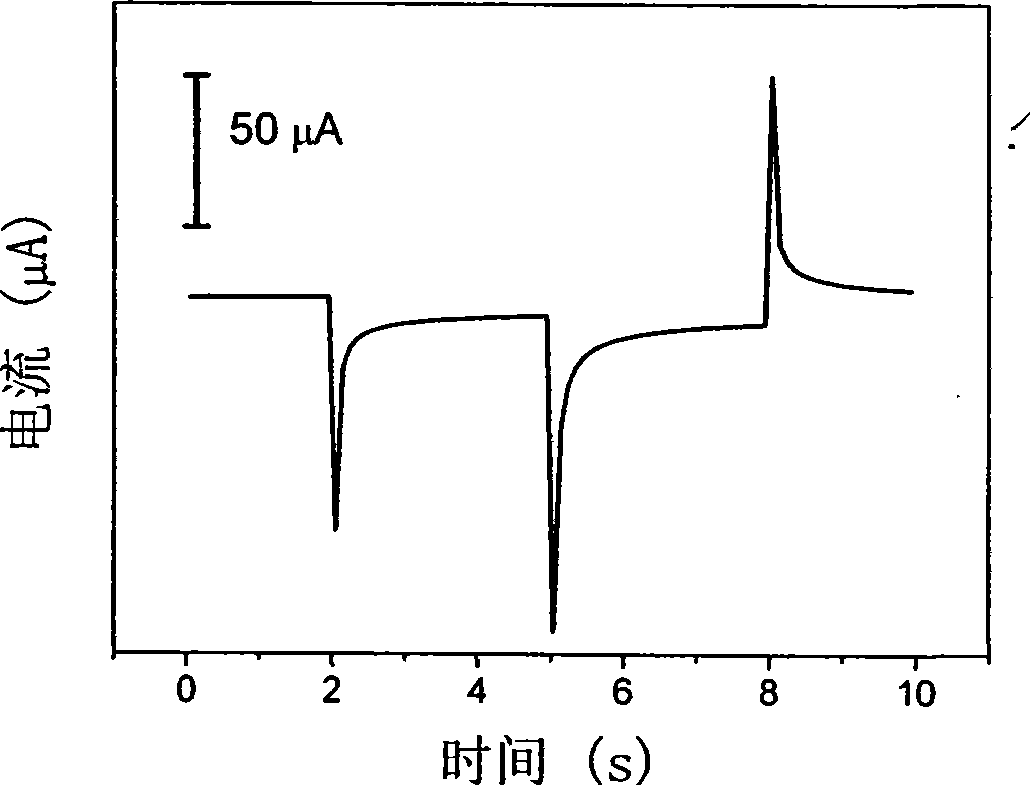Fast quantifying electrolysis method
An analysis method, electroanalysis technology, which is applied in the field of determining the concentration of the analyte by rapidly changing the potential and the amount of electron transfer in this process, which can solve the problems of slow detection speed and achieve low cost, simple operation and high analysis speed. fast effect
- Summary
- Abstract
- Description
- Claims
- Application Information
AI Technical Summary
Problems solved by technology
Method used
Image
Examples
Embodiment 1
[0019] Use the nitroreductase modified electrode as the working electrode, the platinum sheet electrode as the auxiliary electrode, and the saturated calomel electrode as the reference, take a narrow potential interval (-0.60V, -0.80V), and start from 0V to the negative potential step, the first The first step time is 3 seconds, the second step time is 3 seconds, and the third step time is 2 seconds. The pH of the solution to be tested is 7.5, the reduction peak is quantitative, and the solution does not need to be deoxygenated. This method can be used to detect nitrobenzene in water to avoid errors caused by aeration and deoxygenation. However, the oxygen reduction has been completed at the first step and will not cause interference.
Embodiment 2
[0021] Use a glassy carbon electrode as the working electrode, a platinum sheet electrode as the auxiliary electrode, and a saturated calomel electrode as the reference. Take a narrow potential range (0.51V, 0.60V), start a positive potential step from 0V, and the first step time 2 seconds, the second step time is 2 seconds, and the third step time is 2 seconds. The pH of the solution to be tested is 5.6, and the oxidation peak is quantified. This method can be used to detect the concentration of ferulic acid.
Embodiment 3
[0023] Use a glassy carbon electrode as the working electrode, pre-polarize at 2.0V for 2 minutes, then polarize at -1.0V for 1 minute, then immerse in the lead nitrate solution, activate it for 10 minutes under stirring conditions, and use it. The platinum wire electrode is the auxiliary electrode. The silver / silver chloride electrode is used as a reference, and a narrow potential interval (-0.40V, -0.55V) is taken, and the negative potential step is started from 0V, the first step time is 2 seconds, and the second step time is 3 seconds , the third step time is 2 seconds. The pH of the solution to be tested is 5.0, and the reduction peak is quantified. This method can be used to detect lead ions (Pb 2+ )concentration.
PUM
 Login to View More
Login to View More Abstract
Description
Claims
Application Information
 Login to View More
Login to View More - R&D
- Intellectual Property
- Life Sciences
- Materials
- Tech Scout
- Unparalleled Data Quality
- Higher Quality Content
- 60% Fewer Hallucinations
Browse by: Latest US Patents, China's latest patents, Technical Efficacy Thesaurus, Application Domain, Technology Topic, Popular Technical Reports.
© 2025 PatSnap. All rights reserved.Legal|Privacy policy|Modern Slavery Act Transparency Statement|Sitemap|About US| Contact US: help@patsnap.com

